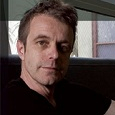In a former interview, we met Pixar storyboard artist Enrico Casarosa. But there are two other Enricos (and some others, maybe?) – the man (of Italian origins, husband and dad) and the comic book artist. And they happen to be reunited in one beautiful creation: a book called The Venice Chronicles, telling of his first big journey back to Italy with his fiancee to both get back in touch with his origins and meet with each other’s parents!
Beautifully drawn in watercolor, this visual journal stands out with his warm and clever sense of storytelling, not so far removed from Miyazaki’s evaluation of details from everyday life. It was such a pleasure chatting with Enrico again about that touching creation of his, sharing all those precious moments of life.

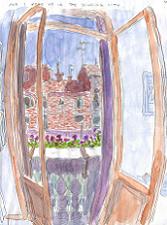 Animated Views: Do you consider yourself as a storyboard artist doing comics or as a comic book artist doing storyboards?
Animated Views: Do you consider yourself as a storyboard artist doing comics or as a comic book artist doing storyboards?
Enrico Casarosa: That’s a great question! Ultimately, I feel I’m a storyteller and I choose different ways, different media to tell those stories. That would be my first answer. The second one is that, probably, I would say storyboard first, just because I’m paying the rent with it and put food on the table for my family. The Venice Chronicles is a specific kind of way of storytelling which is very direct and based on my sketchbook, like a journal. So, when I get an idea, I’m thinking: what do I want out of this? Would I want to see it in a short film form, an animated form, or would I want to see it as a comic book? Until now, frankly, the comic book has been the easiest way to be my own director, the easiest way to put out an idea and a story. It would be much harder if you want to be directing a movie. But comic book and film obviously are beautiful media in their own different way.
AV: How did you come to choose watercolor to express yourself?
EC: It’s funny. I think, in the last few years, more and more I’ve been using it. It’s maybe in the last five or six years that I’ve used watercolor more and more. It’s a little bit connected to Sketchcrawl and the fact that I started doing this kind of drawing marathons, going out all day to draw. I felt watercolor was the best way to do it. It’s something really quick; I can still do it standing around. I did it more and more looking around me, just drawing from what I saw around me. If I wanted to make a movie, I would probably make inspirational images for it on watercolor. And that takes me to the second part of it is that I love Miyazaki. The way he starts working is making images of things that he loves and things he wants to see in the movie. That’s his first step in putting pieces of a story together, and I love that. It’s writing with images, right away before even writing. There’s an immediacy in watercolor. I have very much a taste and love for quick gestural drawing. I’m not too much about terribly detailed pieces of art. Watercolor is quick and you can still convey lighting and expression.
AV: How long did it take you to publish The Venice Chronicles?
EC: It took almost a year to make. It’s actually the longest comic I’ve ever made and it’s been challenging but very satisfying to slowly pull it all together. My wife loves it and we love to share it with so many friends!
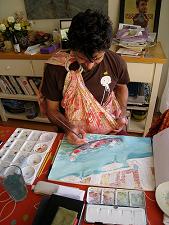 AV: It appeared to me that your Venice Chronicles are above all a love story, with Italy, and with Marit.
AV: It appeared to me that your Venice Chronicles are above all a love story, with Italy, and with Marit.
EC: Yes, I think so. You know, growing up in Italy, then leaving Italy and finding my professional life here in the States has made it so that whenever I go back, I’m a tiny bit of a tourist, and it makes me appreciate things I gave for granted there. I also have this patina of nostalgia that coats most of my visits there. And I think the book has a little bit of that, it’s a bit about standing to value your memories and the places where you grew up. It’s such a great feeling to be in the place where you played around thirty years ago and share that with my girlfriend and having her there… it was really meaningful. I think she could see through my eyes what that experience was.
So, that was a big part of it and I was so glad that we could share it. And yes, this trip was kind of our first meaningful trip. Traveling together is always a relationship test, and it really proved to be easy and great to spend time with her, and even with our families. It was really the beginning of that depth in that relationship, and we felt that happening. The girlfriend has become the woman I’m now happily married and have a wonderful little daughter with [above right: Enrico painting the cover art of The Venice Chronicles holding his baby, Flo].
AV: In the book, you pay homage to Hugo Pratt (the creator of Corto Maltese), who wasn’t really a family man. On the contrary, your family is part many of your creations. Can you tell me about that autobiographic dimension of your work?
EC: It comes a little bit from what I feel is good writing, or good things to share: things that are true to yourself. Even if that’s embarrassing, there’s probably some good writing there. If you’re willing to reveal something of yourself and be personal, chances are you’ll find something that can be universal and that can be shared by other people, and hopefully other people can see themselves into that and understand something about their own life. I like that kind of thinking behind a book or a story. If I can share a little bit of me, I think it’s worth more than completely making it fictional.
Regarding Hugo Pratt, I think that’s one part of the book that I really enjoyed writing because that was a true moment for me to hear about a master of storytelling who is so celebrated in Italy and in France – not so much in the US – and just hear about his personal life. So many great artists – you know, Picasso or Fellini come to mind as well – were just so completely possessed by their own work and by themselves that it was pretty destructive for the people around them. That’s really not me, not that I’d dare to put myself in the category of these creative geniuses, but that’s kind of the point I try to make in the book. That much talent, that much ego can become a real burden in life. Luckily I’m nowhere THAT talented, as much as my work and my passions take time out of my daily life, I could never let them run over it. I just wouldn’t feel like a good person, husband or dad. So, I definitely try to strike a good balance in my life between family and creative projects.
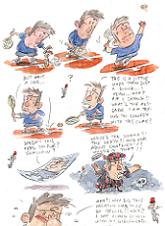 AV: All along the story, you’re asking yourself about the form – how to treat a subject (like the tennis game, or the use of borders), and about truth in art.
AV: All along the story, you’re asking yourself about the form – how to treat a subject (like the tennis game, or the use of borders), and about truth in art.
EC: That’s something not all the reviewers loved, something that you love or hate, I think. For certain moments in the story, I was really able to record on the moment, and that felt great to me. It felt like fresh, like “this is kind of exciting: I’m actually making a comic as I go; I don’t know what’s gonna happen next”. And I really felt that was what I wanted to do with the book.
Once I got back, I really felt like “ok, how do I do that? Am I going to re-tell these things now?” and I just felt it was lacking something. For me, the way to avoid that kind of distance from my work is still try and make it present. So, while I was thinking about these things, I would have to break that third wall and say “ok, I’m gonna have to tell exactly now what is going on my mind and that’s what I would draw and write.” It was like: “How am I going to tell you this story honestly and still in a good, exciting way now that so much time has passed?” That goes back to the point of me wanting to be present at that time in the writing. It’s a direct kind of writing. I wanted to be in the moment and go ahead from there.
Now, if you take the tennis game in the book, it talks to this point: “how much can you really tell in the moment when you’re supposed to be living through it?” So, there’s a little bit of an oxymoron, an impossibility of really living something while you’re drawing, or drawing it while you’re living it. The truth is: very few times, you’re actually really drawing something that’s in front of you. The way to draw exactly what’s happening at that moment is just by capturing the surroundings. And that’s of course the other big part of this book which is also filled with drawing of things I was just looking at, any regular Venetian sketches.
AV: By doing that, you bring different points of view on the same subjects, which brings energy to the narration and makes it fresh and interesting.
EC: Thank you. I was just wrestling with this problem. How do you still make that compelling? Because there’s no actual big drama unfolding. If you’re trying to retell somewhat realistically the happenings of a pleasant vacation, chances are you won’t exactly find a Shakespearean play. So that was the challenge. I’m glad that you like the different layers of thinking through what I was looking at and what I was trying to point at.
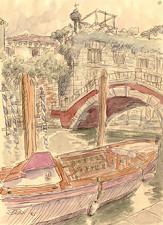 AV: Are they the same kind of problems you encounter when you’re storyboarding a scene?
AV: Are they the same kind of problems you encounter when you’re storyboarding a scene?
EC: Yes. I think that sort of thinking probably comes from my daily job. You’re really trying to maximize the storytelling. It’s not too different from what a good movie does. Very often, a good writer would get some personal material and put it on the page. We have a lot of that here at Pixar. The heart of the movie is and should be personal to the director. And we as story artists are just really trying to help the director get all that material out on film in the best possible way. So, there’s a lot of consideration that may come from my day job. That said, if boarding one sequence, my worries would be slightly different but not terribly.
The other side of it is that it was great to make this book because I made the book I wanted to make. I’m the director. It’s my thing. I can try to please myself first. At Pixar, we work in such a teamwork oriented way that, at the end of the day, you don’t even remember which idea was yours in that given brainstorm. It’s a wonderful process but it can make you feel a tiny bit lost. That’s the reason why you can see a lot of artists in the animation community who run these little projects to just do their own thing without having too many second thoughts about it. At Pixar, it’s a very notes-driven kind of thinking. There’s a lot of thinking and re-thinking. We talked about this in our Ratatouille interview: we call it “re-boarding”. You would do it and re-do it and get it better and better. There’s something quite liberating about doing something straight ahead, leaving the little mistakes, accepting the little mistakes and going forth.
Joann Sfar, a talented comic book artist from France (of Rabbi’s Cat fame) visited us a few years ago and we asked him: “what do you do when you’re not happy with a page?” and he said: “Well, I just do the next one!” I’ve always kept that memory. That’s such a good point. He’s just concerned with telling a story and he’s not gonna be worried about one drawing that isn’t perfect. And that ends up being a style anyway, that imperfection works to its advantage. And I like that. I’m trying to be as loose as possible in these little comics. All of us, especially in story, we love looseness and things that are expressive in a quick, nice way. That was the goal and I feel pretty good about this quick style.
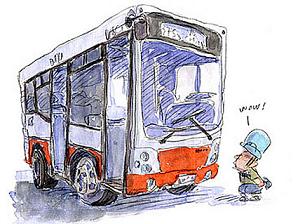
AV: Now, do you have an answer to Mia’s question of that third opus of her adventures?
EC: You know, Ronnie Del Carmen, who is a very good friend, and I were in Angouleme just a few months ago. It was the first time we got to that big comic book convention in France and it was really fun. We spent the whole afternoon talking about Mia 3 and brainstorming. What it could or should be. I feel pretty bad about having left this story stranded. I feel that if I had to do a Mia book, I don’t think it could be even called Mia Issue 3. It would probably be the same story taking up from somewhere in the middle of it and try to make it a free standing tale. Now, the time to do it is the problem, because now with family and Pixar I’m a tad busy. So, I still don’t know exactly when I’ll be able to put some time on Mia. But I’d definitely love to and plan, in the next few years, to try and get to it!
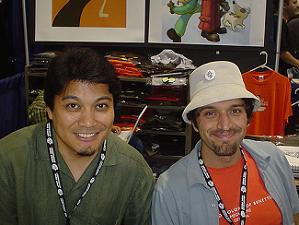
AV: Now that Up is completed, what are you presently working on?
EC: I’m on Cars 2. I’ve been on it for just a few months, just started pretty much. But we’re so excited about Up. Wrapping off that movie has been almost sad because it was such good experience; we’ve had a really good time with Ronnie, Pete Docter and Bob Peterson. We really feel it’s one of those movies to be proud of. Looking at my career, I can pretty much assure you, this is the movie I’m most proud of, so I can’t wait for it to get out there in the world!
In case Amazon is sold out of the book, you can still find copies here.
With gratitude and admiration to Enrico.





